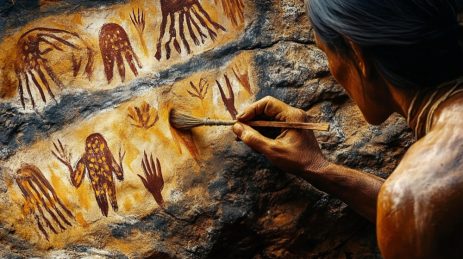EE. UU. endurece las tarifas: cómo afectan las nuevas políticas comerciales a empresas y consumidores en 2025
En 2025, Estados Unidos ha reforzado su estrategia comercial aplicando nuevas tarifas y ajustes arancelarios dirigidos a sectores clave...
Invisible Systems Around Us
Every day, we move through a web of invisible systems that quietly shape our lives, guiding everything from the flow of traffic to the movement of data, energy, and even ideas. These systems exist beneath the surface, hidden in plain sight, yet they determine how our cities breathe, how we connect with one another, and how our modern world maintains its delicate balance. Most of us rarely pause to consider the algorithms deciding what news we see, the network of satellites keeping our devices in sync, or the electricity grid humming tirelessly to keep the night bright. Still, these unseen frameworks are the backbone of civilization, defining both our freedoms and our limits. They operate on trust, precision, and a kind of silent choreography that only reveals itself when something breaks down—a signal lost, a power cut, a server crash. When that happens, the invisible becomes visible, and we remember how fragile this interconnected existence truly is. Yet there is also wonder in knowing how seamlessly these systems collaborate to sustain our daily routines. From digital cloud infrastructures to the ecological processes that regulate our atmosphere, the invisible systems around us are far more than technical marvels; they are living networks of cooperation and dependency that remind us of how deeply interconnected our world has become.
Philosophy of Everyday Life
Philosophy is often imagined as something distant—an abstract field reserved for scholars surrounded by dusty books and grand ideas. Yet, when we look closer, philosophy quietly shapes almost every decision we make. The way we argue about what’s fair, the time we choose to spend with others, the meaning we find in our jobs, or even the gratitude we feel when sipping morning coffee—these all reflect subtle philosophies of everyday life. It’s not about quoting ancient thinkers or debating ethics in lecture halls; it’s about noticing the beliefs that guide us without conscious effort. When you decide to slow down during a busy day, you’re affirming a value about balance. When you compromise in an argument, you’re practicing an ethics of empathy. In this way, philosophy becomes less about answers and more about awareness. The everyday world—its chaos, routines, and small joys—becomes a living text we interpret each day. By pausing to think about why we act as we do, we begin to reclaim a sense of meaning often lost in the rush of habit. Philosophy, then, is not a lofty escape from real life but a gentle lens through which real life becomes richer, more mindful, and infinitely more our own.
Urban Animal Behavior
Cities are often seen as places built entirely for humans, yet they’re also vibrant ecosystems where wildlife learns to adapt, thrive, and sometimes even influence the habits of the people sharing their space. The fox scavenging behind a café, the pigeon navigating crowded streets, or the raccoon deftly opening a trash bin—all reflect an extraordinary capacity for adaptation. Urban environments challenge animals to rethink survival strategies that might have once relied on open fields or forest cover. Noise, artificial lighting, and an abundance of human food waste reshape animal routines, pushing some species toward remarkable behavioral changes. Nocturnal animals, for instance, may alter their schedules to avoid busy hours, while birds adjust their songs to be heard over city traffic. Some species grow bolder through repeated interactions with people, learning that not all humans pose a threat. Others develop specialized diets or nesting habits suited to architecture instead of trees. This coexistence reveals a complex balance where ingenuity determines success, but it also raises questions about how far urban expansion can continue before it begins to erase natural behaviors entirely. Observing these subtle shifts reminds us that wildlife is not just surviving beside us—it is evolving within our cities’ rhythms, adapting to the pulse of modern life with astonishing resilience and intelligence.
The Evolution of Interfaces
From the earliest command-line prompts to today’s seamless voice assistants, the evolution of user interfaces has been a story of human ingenuity shaped by the desire for simplicity. In the beginning, computers demanded fluency in coded language—cryptic commands entered through monochrome terminals that only specialists could navigate. As technology advanced, graphical user interfaces revolutionized computing by introducing icons, windows, and the mouse cursor, transforming machines into tools that anyone could use. This democratization of technology continued with the rise of mobile devices and touchscreens, where the physical act of tapping or swiping brought digital interactions closer to instinct. Now, we find ourselves in another transformative era, one defined by gestures, voice commands, and even neural input, where the interface begins to dissolve entirely into the environment. The lines between user and system are blurring, and the concept of an “interface” is evolving from a visible layer into an invisible bridge. Each step forward reflects a deeper understanding of human behavior, not just technological progress. As artificial intelligence grows more intuitive and adaptive, the next breakthrough may not be a new device or screen at all, but an ecosystem that anticipates our intent before we consciously express it, reshaping how we connect, create, and communicate.
Art as a Medium of Knowledge Transfer
Art has always been more than a mirror to society; it is also a vessel for knowledge, carrying stories, values, and insights across generations. Unlike textbooks or lectures, art communicates in ways that bypass logic and go straight to emotion. A painting, a song, or a performance can transmit complex ideas about identity, history, or morality without a single written word. Through color, form, rhythm, and movement, art captures nuances that language alone often fails to express. For centuries, indigenous communities have used creative expression to preserve oral traditions and ancestral wisdom, while contemporary artists challenge dominant narratives and make hidden truths visible. In classrooms and museums alike, educators are increasingly recognizing the potential of art to bridge disciplines—blending science, philosophy, and culture into a unified experience of learning. Observing or creating art invites reflection and empathy, enabling one to understand perspectives vastly different from one’s own. When we engage with art thoughtfully, we do not only appreciate its beauty but also decode its symbolic layers, gaining access to knowledge that is both intellectual and emotional. In this way, art becomes not just a reflection of what we know, but an active participant in shaping how we come to know it.
Slow Technologies
In a world obsessed with faster downloads, instant messages, and next-day delivery, the concept of “slow technologies” feels almost radical. Yet, as many people are discovering, slowing down our relationship with technology can be an act of liberation. The movement doesn’t argue for abandoning progress but rather for reimagining how we use our devices—favoring technologies that enhance presence, mindfulness, and connection over those that demand constant attention. Slow technologies might take the form of thoughtfully designed objects that perform a single task beautifully, or software that prioritizes calm interaction instead of endless alerts and scrolling. The idea challenges the belief that innovation must always be tied to speed or efficiency. Instead, it invites us to ask: what if we crafted tools that encouraged reflection and durability? What if our devices supported our well-being rather than draining it? In embracing this slower pace, users begin to reclaim their time and attention, forming a more intentional bond with the digital tools that shape their daily lives. Slow technologies are less about nostalgia and more about balance—a conscious effort to design and choose technology that respects not only human needs but also the rhythms of nature, creativity, and rest.
The Science of Sleep
Sleep remains one of the most mysterious and vital processes in human biology. Every night, our bodies enter a carefully orchestrated rhythm of rest and renewal that affects nearly every aspect of our health. Behind the closed eyes and still body, the brain is remarkably active, cycling through stages that repair tissues, consolidate memories, and regulate emotions. These stages—light sleep, deep sleep, and rapid eye movement—each serve unique and essential purposes. Scientists have discovered that during deep sleep, the body releases growth hormones and clears away cellular waste, while REM sleep supports creativity and learning. Yet, despite its importance, modern life often disrupts this delicate balance. Late-night screen time, stress, and irregular schedules interfere with our internal clocks, leading to fatigue, irritability, and long-term health risks. The science of sleep is uncovering just how connected rest is to mental clarity, immune strength, and even decision-making. Understanding this complex process helps us move beyond seeing sleep as mere downtime. Instead, it is an active and necessary state of regeneration that shapes who we are each day. Our challenge now is to align science with daily habits—learning to respect the natural rhythms that our bodies have relied on for millennia.
Cultural Anthropology
Cultural anthropology is the study of human societies, their values, behaviors, and the ways people make sense of their worlds through shared symbols and traditions. It seeks to understand not only the outward customs of a community but the deeper meanings behind them—how beliefs, languages, and social practices evolve and interact over time. Unlike archaeology or physical anthropology, which focus on the material or biological aspects of humanity, cultural anthropology places human experience at the center. It asks questions about identity, power, kinship, and adaptation in an increasingly connected yet diverse world. Fieldwork, often involving long-term immersion in a community, remains at the core of anthropological research. Through observation and participation, anthropologists gain insight into how individuals navigate the balance between tradition and change. The discipline also confronts its own ethical challenges, recognizing the responsibility to represent communities with respect and accuracy. In an era shaped by globalization, migration, and digital communication, cultural anthropology remains a vital lens through which to understand how cultures influence one another and how people continually redefine what it means to belong. Its findings remind us that culture is dynamic, fluid, and endlessly creative—an ever-changing tapestry woven from the collective choices and stories of humanity.
Microhistory of a Single Idea
Every idea, no matter how vast it may seem in its influence, begins as something faint and uncertain—a small spark in one human mind. The microhistory of a single idea reveals the slow, often invisible process by which a thought becomes part of the shared language of a culture. It might start with a note scribbled on the margin of a book or a half-formed question spoken aloud in a quiet room. From there, it travels through letters, conversations, arguments, and moments of doubt. Some ideas vanish before they find soil to grow in, but a few survive the friction of misunderstanding and the weight of time. Microhistory invites us to pause and trace these delicate movements, uncovering how seemingly personal reflections ripple into the broader current of history. When we follow one idea closely, we begin to see how context shapes discovery—that what emerges as innovation often depends on coincidence, chance meetings, or the social and political climate of a given moment. The story of an idea is never only intellectual; it is emotional, embodied, and profoundly human. By scaling down the lens, we recognize that the grand narratives of progress are built from tiny acts of attention, persistence, and connection. Each idea, no matter how small, carries with it a record of the world that made it possible.
















